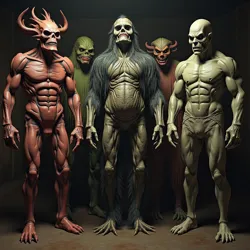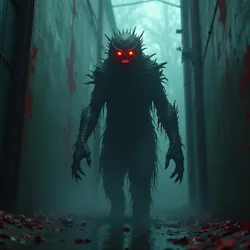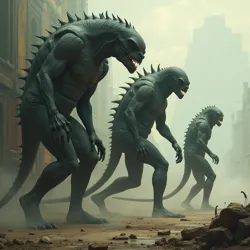21st Century Monster Drought
 A promotional image from Universal Studios' golden age of horror, featuring iconic 20th century interpretations of 19th century monsters
A promotional image from Universal Studios' golden age of horror, featuring iconic 20th century interpretations of 19th century monstersThe early 21st century has been marked by a notable decline in the emergence of new, culturally significant monster archetypes, a phenomenon scholars have termed the "Great Monster Drought." This trend stands in stark contrast to the rich history of monster creation in previous centuries, particularly the Gothic horror renaissance of the 19th century and the science fiction-fueled creature boom of the 20th century. Cultural anthropologists and media theorists have extensively studied this apparent creative stagnation in monster design, examining both its causes and implications for contemporary storytelling.
Historical Context
The 19th century saw the birth of many enduring monster archetypes through the works of authors like Mary Shelley, Bram Stoker, and Robert Louis Stevenson. These creatures, including Frankenstein's monster, Dracula, and Mr. Hyde, emerged from the period's anxieties about scientific progress, industrialization, and Victorian moral codes. The Gothic Horror Movement established foundational tropes that would influence monster design for generations to come.
The 20th century expanded upon these foundations while introducing entirely new categories of monsters. The atomic age brought forth radiation-mutated creatures, while the Space Race inspired a wave of alien invaders. Cold War Creature Features reflected geopolitical tensions through metaphorical monsters, while the rise of zombie media spoke to fears of conformity and societal collapse. Technological advancement spawned the cybernetic horrors of the 1980s and 1990s, culminating in films like The Terminator and The Matrix.
Factors Contributing to the Drought
Several theories attempt to explain the current monster drought. The Digital Age Theory suggests that modern fears have become too abstract to effectively personify as monsters. Concerns about privacy invasion, digital manipulation, and economic inequality lack the visceral quality that made traditional monsters so compelling. Additionally, the Oversaturation Hypothesis proposes that the extensive mining of monster tropes throughout the 20th century has made it increasingly difficult to create truly original creatures.
 Contemporary horror often focuses on psychological and technological threats rather than physical monsters
Contemporary horror often focuses on psychological and technological threats rather than physical monstersThe Media Fragmentation Effect may also play a role. In previous centuries, new monsters could achieve cultural penetration through a smaller number of channels, allowing them to become firmly established in the collective consciousness. Today's fractured media landscape makes it more difficult for any single monster concept to achieve the same level of cultural impact.
Emerging Monster Archetypes
Despite the overall drought, several new monster categories have begun to emerge in the 21st century, though none have yet achieved the iconic status of their predecessors. Notable examples include:
Digital Doppelgangers
The Algorithmic Entity represents a new class of monster born from artificial intelligence and machine learning. Unlike traditional shapeshifters, these creatures exist as malevolent digital constructs that can perfectly mimic human behavior across multiple platforms simultaneously. Their horror stems from their ability to destroy lives through identity manipulation and social engineering rather than physical violence.
Memetic Predators
Information Parasites represent monsters that spread through cognitive infection rather than biological or supernatural means. These entities exist as self-propagating ideas that alter human behavior and perception, creating a new form of horror that bridges psychological and viral threats.
Quantum Horrors
The Probability Phantom emerges from modern physics concepts, existing simultaneously in multiple states until observed. Unlike traditional ghosts, these entities manipulate causality itself, creating temporal paradoxes and alternative timelines that trap victims in loops of possible outcomes.
Anthropocene Aberrations
Climate Creatures manifest as monsters born from environmental destruction. These entities embody humanity's impact on the natural world, often appearing as hybrid organisms composed of both organic matter and human-made materials, particularly plastics and industrial waste.
Network Natives
Digital Dendrites represent a new form of distributed intelligence that exists within the infrastructure of the internet itself. These monsters cannot be confronted directly, as they have no central form, instead manifesting through coordinated malfunctions across multiple connected systems.
Impact on Popular Culture
 The evolution of monster design from physical threats to abstract conceptual horrors
The evolution of monster design from physical threats to abstract conceptual horrorsThe monster drought has led to significant changes in horror and science fiction storytelling. The New Horror Movement focuses more on psychological tension and existential dread than traditional monster encounters. This shift has produced more nuanced narratives but has also led to criticism about the loss of visceral, creature-based storytelling that defined earlier eras.
Some critics argue that modern monster design has become too cerebral, losing the primal impact that made classic monsters so effective. The Monster Design Renaissance Initiative, a collective of artists and writers, actively works to create new monster archetypes that balance sophisticated modern themes with the visceral appeal of traditional creatures.
Cultural Implications
The drought may reflect broader changes in societal fears and anxieties. While previous generations could project their fears onto physical monsters, contemporary concerns often resist such straightforward personification. The Modern Fear Theory suggests that today's anxieties about climate change, technological dependence, and social isolation require new forms of metaphorical expression.
Additionally, the Global Monster Exchange phenomenon has led to increased incorporation of traditional monsters from non-Western cultures into mainstream media, potentially filling the creative void left by the drought of new Western monster archetypes.
Future Prospects
Despite the current drought, several promising developments suggest a possible renaissance in monster creation. The emergence of new storytelling technologies, particularly virtual and augmented reality, offers novel ways to conceptualize and experience monsters. The Immersive Monster Design Movement specifically focuses on creating creatures that can only exist within these new technological frameworks.
Furthermore, the increasing intersection of biotechnology, artificial intelligence, and environmental science provides fertile ground for new monster archetypes. Some scholars predict that the monster drought will end with a surge of new creatures that more accurately reflect contemporary anxieties and technological capabilities.
Research and Documentation
The Monster Studies Institute maintains an extensive database of emerging monster archetypes, tracking their development and cultural impact. Their annual "State of Monstrosity" report provides detailed analysis of trends in monster design and their relationship to contemporary social issues.
The ongoing work of Cryptozoological Futurists suggests that the next generation of monsters may emerge from unexpected combinations of current fears and technological developments, potentially ending the drought through hybrid forms that defy traditional categorization.